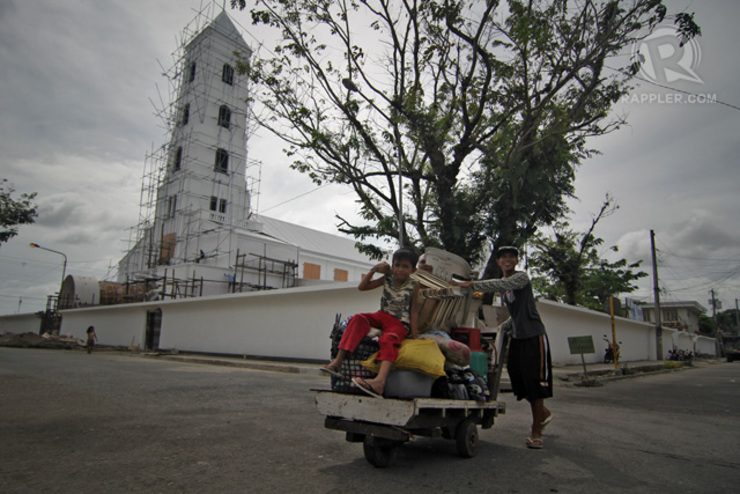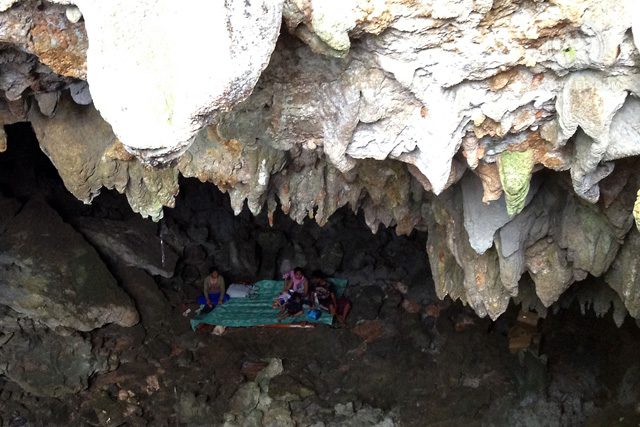SUMMARY
This is AI generated summarization, which may have errors. For context, always refer to the full article.

MANILA, Philippines (UPDATED) – Millions of people in the Philippines began seeking shelter in churches, schools, and other makeshift evacuation centers on Friday, December 5, as a Typhoon Ruby (international name: Hagupit) bore down on the disaster-weary nation.
The storm, which would be the strongest to hit the country this year, is expected to impact more than 50 provinces – more than half the nation – including communities devastated by Super Typhoon Yolanda (Haiyan) in 2013.
State weather bureau PAGASA identified 47 provinces as “potential high-risk areas,” which will be affected by the typhoon’s 600-kilometer diameter cloud cover. These provinces, including the National Capital Region, are home to a total ot 66.6 million Filipinos, based on 2010 census data from the Philippine Statistical Authority.
Authorities said more than 500,000 families, or about 2.5 million people, in Eastern Visayas and surrounding regions would be evacuated ahead of Ruby’s expected landfall on Saturday night or Sunday.
Social Welfare Secretary Corazon Soliman said 100,000 families, or about half a million people, were already in evacuation centers as of riday night, and many more would follow on Saturday.
In the Bicol alone, which sits in Ruby’s direct path, the government was aiming to move 2.5 million into evacuation centres, regional civil defense director Bernardo Alejandro told Agence France-Presse.
As early as Thursday afternoon, in fact, provincial governments in Bicol, the traditional typhoon belt of the country, ordered pre-emptive evacuation. (READ: Bicol braces for landslides, lahar flow)
The province of Albay, which has been recognized for its disaster preparedness program, said Friday it was seeking to evacuate 600,000 people before Ruby strikes.
‘Gripped with fear’
“Everyone here is gripped with fear,” Rita Villadolid, 39, told Agence France-Presse as she sat with her family and hundreds of other people inside a sports stadium in Tacloban, one of the cities still yet to recover from Yolanda.
Elsewhere in Tacloban, a coastal city of 220,000 people on the eastern island of Leyte, people began flooding into churches and schools with little more than bags of clothes.
Barangay 88, the village in Tacloban City that was hardest hit by Yolanda last year, started evacuating residents Thursday night.
The city of Ormoc in Leyte and Bantayan Island in Cebu reported early preparations and pre-emptive evacuation as well. (READ: LGUs prepare for #RubyPH)
Yolanda, the strongest storm ever recorded on land with winds of 315 kilometres (195 miles) an hour, killed more than 6,000 and left about 1,000 more missing when it tore across the central Philippines in November 2013.
Ruby was generating winds of 215 kilometers (133 miles) an hour on Friday as it tracked toward the Philippines from the Pacific Ocean.
Direct hit
This would still make Ruby the strongest storm to hit the Philippines this year, and it would also bring storm surges more than one storey high to many coastal areas, according to state weather agency PAGASA.
In Iloilo City in Western Visayas, the local government declared a “state of imminent danger” Friday morning, as it sought to free up funds for pre-disaster evacuation and other emergency requirements.
In Central Visayas, the province of Cebu went on “red alert” to activate all of its disaster risk reduction and management units. Towns in Northern Cebu are still reeling from Yolanda. Cebu ordered the evacuation of communities in danger zones, prepositioned relief goods, and prepared equipment to repair power facilities.
In Bohol province, which was struck by a powerful earthquake in October 2013, the goverment was on “full alert.” Governor Edgar Chatto told Rappler that he already ordered preemptive evacuation in vulnerable areas, prepared goods, and suspended classes in all levels. Officials also postponed an event in Manila next week to promote Bohol tourism.
In Misamis Oriental, Governor Yevgeny Vincente Emano has ordered disaster officials to prepare to “take care” of around 42,000 persons to be affected by Ruby, according to a Philippine Information Agency update on Thursday, December 4.
Caraga, for its part, has placed itself under “red alert status,” said regional disaster director Liza Mazo, as quoted by MindaNews.
Ruby’s weather band was 600 kilometer wide and would affect 55 of the nation’s 80 provinces – or around 1,000 towns and cities – according to PAGASA.

According to the US Navy’s Joint Typhoon Warning Center, Metro Manila, the nation’s capital with a population of more than 12 million people, could also suffer a direct hit, but the Philippine weather bureau had a slightly different forecast.
Mayors of the capital region’s cities held an emergency meeting on Friday to begin preparations, as Ruby was expected to bring rains over the area on Monday its way out of the Philippines. Metro Manila was placed on alert for possible flooding.
Authorities also identified landslide-prone villages in Metro Manila, most of them in Quezon City.
The Philippines is often the first major landmass hit by typhoons and major tropical storms that are created in the Pacific Ocean. It endures about 20 major storms a year, many of them deadly.
The Philippines, a developing nation of 100 million people, has in recent years faced unusually strong storms that scientists have warned are linked to climate change.
More than 1,900 people were left dead or missing in December 2012 after Typhoon Pablo (international name: Bopha) hit the southern Philippine island of Mindanao, an area that does not normally experience major storms.
In December 2011, 1,268 people were killed when Tropical Storm Sendong (international name: Washi) caused massive flooding in another part of Mindanao.
Yolanda, Pablo, and Sendong were the world’s deadliest storms of the past 3 years. – with reports from Agence France-Presse, Voltaire Tupaz, Carmela Fonbuena, Bea Cupin, Ayee Macaraig, Angela Casauay, Paterno Esmaquel II, Rhaydz Barcia, and Joselito Villasis/Rappler.com
Add a comment
How does this make you feel?
There are no comments yet. Add your comment to start the conversation.